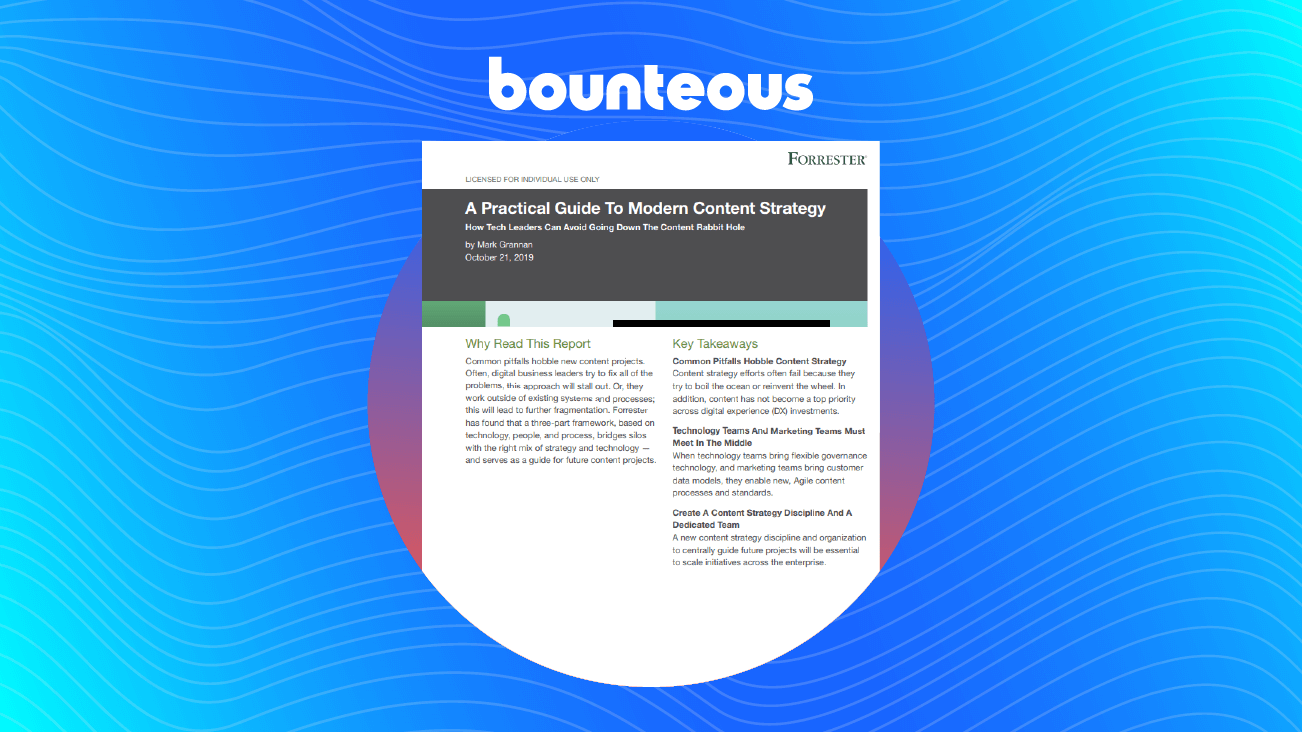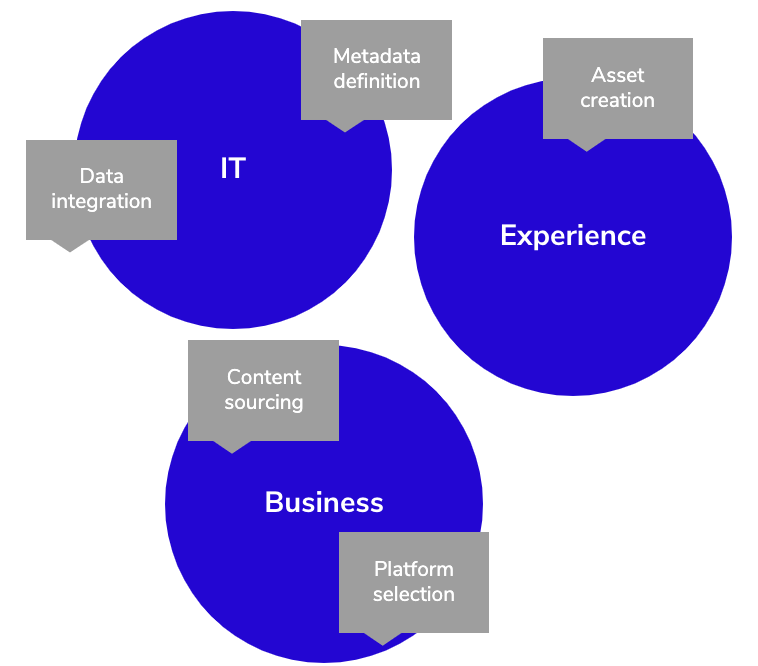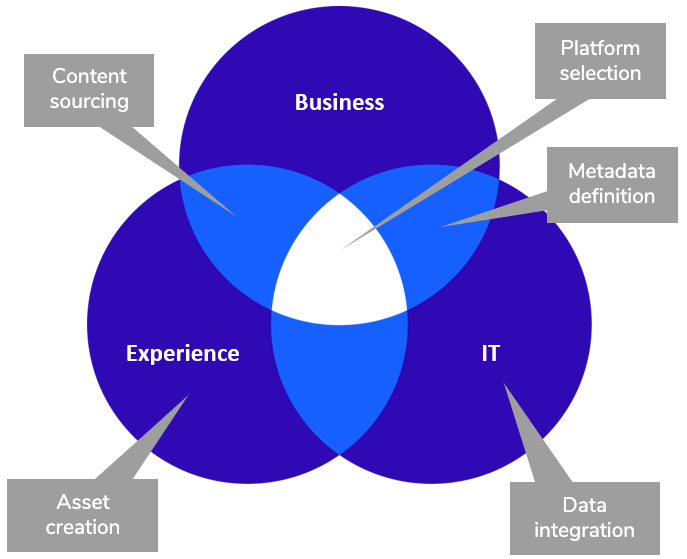Press Release: Bounteous Included in Forrester Report, “A Practical Guide To Modern Content Strategy”

Bounteous, a leading insights-driven digital experience agency, is included in a recent report by Forrester, an influential global research and advisory firm for business and technology leaders, titled, “A Practical Guide To Modern Content Strategy.”
In this report, authored by analyst Mark Grannan, Forrester conducted 30 interviews with end-user organizations, technology providers, and service providers to understand the common pitfalls that plague new content projects. The findings show that teams routinely fall into two common traps when setting out to create or refresh their content strategies: boiling the ocean or trying to reinvent the wheel.
Forrester has found that a three-part framework — based on technology, people, and process — bridges silos with the right mix of strategy and technology and serves as a guide for future content projects.
Bounteous VP of Experience Design Amanda Ruzin, who is quoted in the report discussing the future of content as a discipline, recommends the creation of a content center of excellence.
“Failures of customer experience are often caused by siloing between Business, Experience, and Technology groups,” Ruzin said. “Companies who embrace collaboration across functions will have an advantage in the marketplace because successfully integrated enterprise content strategy will be required to enable the next ‘gold standard’ in customer experience. Content Strategy needs to be thought of in more contexts than just marketing or design."
Inner organizational silos create roadblocks to the creation and governance of content that drives a cohesive user experience.
For content strategy to expand to cover the entire organization, this requires Content Operations, which addresses tools, process, and governance of content across silos within an organization. Content Ops groups enable content strategy at scale by facilitating the cross-functional collaboration that is required in order to achieve data-driven insights, personalization, and superior customer experiences across the digital ecosystem.
“Content Strategy is a team sport at Bounteous,” said Ruzin. “We have content strategists who are specialists, of course, but our copywriters, social media strategists, SEO experts, product managers, enterprise architects (and more!) work collaboratively to remove roadblocks to the creation and governance of content that drives a cohesive user experience.”
Enterprise content strategy must be addressed throughout projects and across programs, breaking down traditional departmental silos.
The report, “A Practical Guide To Modern Content Strategy,” is now available online to Forrester customers or for purchase.
What We Think About Content
We take content seriously at Bounteous. Some of our recent content pieces have tackled the internal and external challenges of content creation.
Content Strategy is All Around Your Project
Content strategy means giving people the content they need, when they need it, in a way that makes sense. This sounds great, but it’s admittedly abstract. How and where does this actually play out in a project? While there’s no single answer, you can look to the practice itself as a starting point.
Content isn’t interpreted in a vacuum — you notice what it looks like, what it says, what form it's in, how you receive it, and a million other context clues that play into how you interpret the information in front of you. The thinking that goes into the content of an email is different than that of a billboard, which is different than a social post.
Similarly, content strategy isn’t a single, siloed project activity that happens, is finished and is never thought of again — not if you want your content to shine. Walkthrough the main ways we weave content into every stage and discipline involved in building an experience.
What We Talk About When We Talk About Content
Content strategy is something that needs to be addressed early in a project, because it directly impacts the experience and implementation. Often, content is pushed farther and farther into a project until it’s too late, leading to delays and trepidation.
When we talk about content at the kickoff of a project in detail, we can ask questions and work through an inventory and audit of an organization’s content. This helps give a good sense of what we’re saying before we make a single wireframe or comp — which ultimately helps the project run better then if you had waited until the end to discuss content.
Content drives the overall experience. No matter how much time you invest in choosing a robust platform, creating a sharp user flow, or establishing brand guidelines, all of it will have limited success – all of it – if your content doesn’t support your users and your business. User experience (UX) and user interfaces (UI) are of course instrumental in connecting us to what we need to do, but the content is why we’re there in the first place.
What We Talk About When We Talk About Information Architecture
Powerful technology, extensible design systems, and beautiful user interfaces aren’t enough to make an effective user experience. A well-defined content strategy and strong information architecture are the most important missing links between your great idea and a successful execution.
Content strategy addresses the information and content that users need; it defines where it should live, how it should get there, how users can access it, and how an organization can support it, while keeping the user’s needs at the center. In this way, content strategy creates experiences that drive results. If this sounds like user experience, you’re right; content strategy and user experience run parallel and often overlap, because information expression is key to the user experience.
Bringing Numbers into the Picture: Insight-Driven Design
We view insights as ideas that incorporate multiple lenses – quantitative research, big data, qualitative research, business goals, and KPIs – and focus on what best applies to a particular challenge. For example, data might tell you that people are abandoning their shopping cart two-thirds of the way through checkout. But while that data is important for identifying an area of focus, it doesn’t hand us the solution.
At that point, adding in qualitative research can help you understand why the behavior is happening. While quantitative data (like cart abandonment) focuses the research, qualitative user observation allows you to witness the cart-abandonment issue in practice. The combination of data and observation can help reveal and develop insights that address the friction points.
Considering Needs and Actions to Create Meaningful Customer Experiences
Designers and engineers don’t always see things the same way, which means their priorities aren’t always the same on every project. But, these two groups are often critical stakeholders behind a project getting off the ground and completed successfully. So, if you want your project to be consistent, timely, and impactful, it’s critical to have a system in place for effective communication. Creating a common vocabulary can help to bring the complexity together and establish a system for communication.




